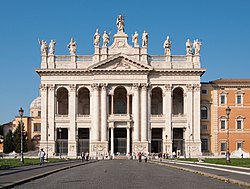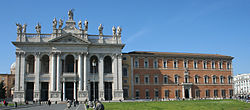


Lateran and Laterano are names for an area of Rome, and the shared names of several buildings in Rome. The properties were once owned by the Lateranus family of the Roman Empire. The Laterani lost their properties to Emperor Constantine who allegedly gave them to the Bishop of Rome though this traditional report has been most likely based on the document Donation of Constantine which has been proven to be a forgery. [1] [2]
Contents
The most famous Lateran buildings are the Lateran Palace, once called the Palace of the Popes, and the Archbasilica of Saint John Lateran, the cathedral of Rome, which while in Rome, and not in the Vatican, are properties of the Holy See, and have extraterritorial privileges as a result of the 1929 Lateran Treaty with Italy. As the official ecclesiastical seat of the pope, Saint John Lateran contains the papal cathedra . The Lateran is Christendom's earliest basilica.
Attached to the basilica is the Lateran Baptistery, one of the oldest in Christendom. Other constituent parts of the Lateran complex are the building of the Scala Sancta with the Sancta Sanctorum and the Triclinium of Pope Leo III.
Another basilica in the neighborhood is San Clemente al Laterano.
The Pontifical Lateran University, or simply Lateranum, is one of the pontifical universities of Rome. An ecclesiastical college in the Philippines was named after the Archbasilica of Saint John Lateran, the Colegio de San Juan de Letran, founded in 1620.